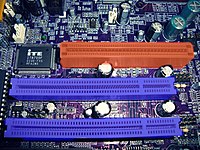And it doesn't mater if the expansion card is an AGP Pro, AGP Universal, or regular AGP Slot. The fact remains that AGP is a Mature PC Graphics Standard, in need of replacement because it's out-dated. The current state-of-the-art Expansion Board for video graphics is the PCIe interface.
AGP Inline Memory Module (AIMM) also known as Graphics Performance Accelerator (GPA) is an expansion card that fits in the AGP slot of PC motherboards based on Intel 815 chipsets with onboard graphics, like the ASUS CUSL-2 with an AGP Pro slot and Abit SH6 with an AGP Universal slot. The Brown slot situated near middle of the board is the AGP slot. Most motherboards have the slots Colour Coded: Brown for AGP, White for PCI, and Black for ISA; depending on the maker this may vary. Figure 2 demonstrates a Socket 754 AMD™ Motherboard with a Green AGP slot. If it's a UNIVERSAL slot, then yes. If it's a 4x-only or 4x/8x, no. The card and slot connectors are mechanically keyed to prevent from plugging stuff together that doesn't work together. Look at the FAQ at www.ati.com for pictures and explanations.
Introduction to the AGP bus
The AGP bus (short for Accelerated Graphics Port) was released in May 1997 for Slot One chipsets, then was later released for Super 7 chips in order to manage graphical data flow, which had grown to large to be handled by a PCI bus. The AGP bus is directly linked to the processor's FSB (Front Side Bus) and uses the same frequency, for increased bandwidth.
The AGP interface was developed specifically to connect with the video card, by opening a direct memory access (DMA) channel to the graphics board, bypassing the input-output controller. Cards which employ this graphics bus theoretically require less on-board memory; because they can directly access graphical data (such as textures) stored in central memory, their cost is hypothetically lower.

Version 1.0 of the AGP bus, which used 3.3 V of power, had a 1X mode that could send 8 bytes every two cycles, and a 2x mode for transferring 8 bytes per cycle.
In 1998, AGP version 2.0 added AGP 4X, which could send 16 bytes per cycle. Version 2.0 of AGP was powered by 1.5 V, and AGP 2.0 'universal' connectors which could support either voltage were released.
AGP version 3.0, released in 2002, doubled the speed of AGP 2.0 with a new AGP 8x mode.
Characteristics of AGP
The AGP 1X port operates at 66 MHz, as opposed to 33 MHz for a PCI bus, giving it a top speed of 264 MB/s (vs. 132 MB/s, shared between all the cards, for PCI). This gives AGP better performance, especially when displaying complicated 3D scenes.
When AGP 4X was released, its speed went up to 1 GB/s. This generation of AGP used 25 W of power. The next generation was named AGP Pro and used 50W.
AGP Pro 8x offers speeds of 2 GB/s.
The transfer speeds for the various AGP standards are:
- AGP 1X: 66.66 MHz x 1(coef.) x 32 bits /8 = 266.67 MB/s
- AGP 2X: 66.66 MHz x 2(coef.) x 32 bits /8 = 533.33 MB/s
- AGP 4X: 66.66 MHz x 4(coef.) x 32 bits /8 = 1.06 GB/s
- AGP 8X: 66.66 MHz x 8(coef.) x 32 bits /8 = 2.11 GB/s
It should be noted that each of these AGP standards is backwards-compatible, meaning that AGP 4X or AGP 2X cards can be inserted into an AGP 8X slot.
AGP Connectors
Recent motherboards are built with a general AGP connector which can be identified by its brown color. There are three types of connectors:
- AGP 1.5 volt connector:
Agp Universal Slot Poker
- AGP 3.3 volt connector:
- Universal AGP connector:
Summary
Here is a table summarising the technical specifications for each version and mode of AGP:| AGP | Voltage | Mode |
|---|---|---|
| AGP 1.0 | 3.3 V | 1x, 2x |
| AGP 2.0 | 1.5 V | 1x, 2x, 4x |
| AGP 2.0 universal | 1.5 V, 3.3 V | 1x, 2x, 4x |
| AGP 3.0 | 1.5 V | 4x, 8x |
Agp Universal Slot Machine

Version 1.0 of the AGP bus, which used 3.3 V of power, had a 1X mode that could send 8 bytes every two cycles, and a 2x mode for transferring 8 bytes per cycle.
In 1998, AGP version 2.0 added AGP 4X, which could send 16 bytes per cycle. Version 2.0 of AGP was powered by 1.5 V, and AGP 2.0 'universal' connectors which could support either voltage were released.
AGP version 3.0, released in 2002, doubled the speed of AGP 2.0 with a new AGP 8x mode.
Characteristics of AGP
The AGP 1X port operates at 66 MHz, as opposed to 33 MHz for a PCI bus, giving it a top speed of 264 MB/s (vs. 132 MB/s, shared between all the cards, for PCI). This gives AGP better performance, especially when displaying complicated 3D scenes.
When AGP 4X was released, its speed went up to 1 GB/s. This generation of AGP used 25 W of power. The next generation was named AGP Pro and used 50W.
AGP Pro 8x offers speeds of 2 GB/s.
The transfer speeds for the various AGP standards are:
- AGP 1X: 66.66 MHz x 1(coef.) x 32 bits /8 = 266.67 MB/s
- AGP 2X: 66.66 MHz x 2(coef.) x 32 bits /8 = 533.33 MB/s
- AGP 4X: 66.66 MHz x 4(coef.) x 32 bits /8 = 1.06 GB/s
- AGP 8X: 66.66 MHz x 8(coef.) x 32 bits /8 = 2.11 GB/s
It should be noted that each of these AGP standards is backwards-compatible, meaning that AGP 4X or AGP 2X cards can be inserted into an AGP 8X slot.
AGP Connectors
Recent motherboards are built with a general AGP connector which can be identified by its brown color. There are three types of connectors:
- AGP 1.5 volt connector:
Agp Universal Slot Poker
- AGP 3.3 volt connector:
- Universal AGP connector:
Summary
Here is a table summarising the technical specifications for each version and mode of AGP:| AGP | Voltage | Mode |
|---|---|---|
| AGP 1.0 | 3.3 V | 1x, 2x |
| AGP 2.0 | 1.5 V | 1x, 2x, 4x |
| AGP 2.0 universal | 1.5 V, 3.3 V | 1x, 2x, 4x |
| AGP 3.0 | 1.5 V | 4x, 8x |
Agp Universal Slot Machine
More information
- Compare: AGP mother boards
- Compare: AGP graphics cards

